Database
Our database is free to use for all history and archaeology enthusiasts. If you use our database, please do not forget to cite correctly:
Mägi, Marika; Palm, Piia Sandra. Archaeological Artefacts of Saaremaa. Foundation Osiliana / Tallinn University. Accessed: date.
The Osiliana Archaeological Database presents artefacts from Saaremaa and the surrounding small islands.
The database contains mainly Iron Age and Medieval finds that can be classified.
Undated metal or other pieces were generally excluded from the database.
Ceramics are represented by isolated examples.
The database is a work in progress and is constantly being updated.
Ure
Bronze sheet, rolled together. Ends slightly in between each other and there is a thin line at one end.


Bronze sheet, rolled together. Ends slightly in between each other and there is a thin line at one end.
Ure
Socketed axe, iron. With a narrow blade. The height is 11 cm, the diameter of the handle is around 2 cm. Socketed axes were during a long period widespread in Finland, the Eastern Baltic and Northwestern Russia. 93 socketed axes of the same type as in Ure have been found in the Kohtla deposit, North-Estonia, and dated to the 1st -4th century AD.


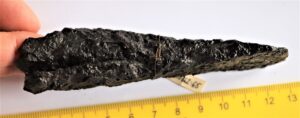

First photo: Jaana Ratas.
Socketed axe, iron. With a narrow blade. The height is 11 cm, the diameter of the handle is around 2 cm. Socketed axes were during a long period widespread in Finland, the Eastern Baltic and Northwestern Russia. 93 socketed axes of the same type as in Ure have been found in the Kohtla deposit, North-Estonia, and dated to the 1st -4th century AD (Oras et al 2018; Saage, et al 2018).
Literature:
Oras, E., Kriiska, A., Kimber, A., Paavel, K. & Juus, T. 2018. Kohtla-Vanaküla weapons and tools deposit: an Iron Age sacrificial site In North-East Estonia. – Estonian Journal of Archaeology 2018, 22, 1, 5–31. https://doi.org/10.3176/arch.2018.1.02.
Saage, R., Kiilmann, K. and Tvauri, A. 2018. Manufacture Technology of Socketed Iron Axes. – Estonian Journal of Archaeology 2018, 22, 1, 51–65. https://doi.org/10.3176/arch.2018.1.04.
Ure
Bracelet, bronze. Stretched loose, shaped like a band, the cross-section is flat and curvy. The width is even and there are 5-6 thin transverse lines at both ends. Bracelets of this type were commin the Roman Iron Age Saaremaa and surroundings.


Bracelet, bronze. Stretched loose, shaped like a band, the cross-section is flat and curvy. The width is even and there are 5-6 thin transverse lines at both ends. Bracelets of this type were commin the Roman Iron Age Saaremaa and surroundings (Lang 2007, 212-213).
Literature:
Lang, V. 2007. The Bronze and Early Iron Ages in Estonia. – Estonian Archaeology, 3. Tartu. Read the article: here.
Ure
Razor fragment, iron. Part of the tang and the blade. The tang has flat cross-section. Similar knives have been found in North Estonian 3rd-5th-century graves.
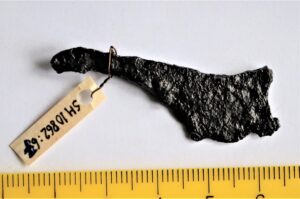


Parallel:

A razor similar to the Ure specimen is known from the Lagedi grave, North-Estonia (Lang 2007, joon. 79: 1).
Razor fragment, iron. Part of the tang and the blade. The tang has flat cross-section. Similar knives have been found in North Estonian 3rd-5th-century graves (Lang 2007, 143).
Literature:
Lang, V. 2007. The Bronze and Early Iron Ages in Estonia. – Estonian Archaeology, 3. Tartu. Read the article: here.
Ure
Knife, iron. The spine is a bit curvy, 6 mm wide. The cross-section of the tang is flat quadrilateral, and the tip of the tang is broken.
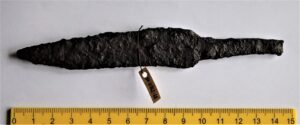

Knife, iron. The spine is a bit curvy, 6 mm wide. The cross-section of the tang is flat quadrilateral, and the tip of the tang is broken.
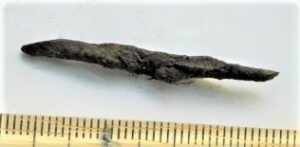
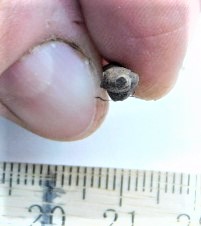
Iron rod. 3.5 cm long, both ends are sharp.

Ure
Nail, iron. 1 cm long and with a sharp tip. The knob is circular. Probably a decorative nail.

Ure
Artefact fragment, iron, flat.
The negative value refers to time Before Christ.









